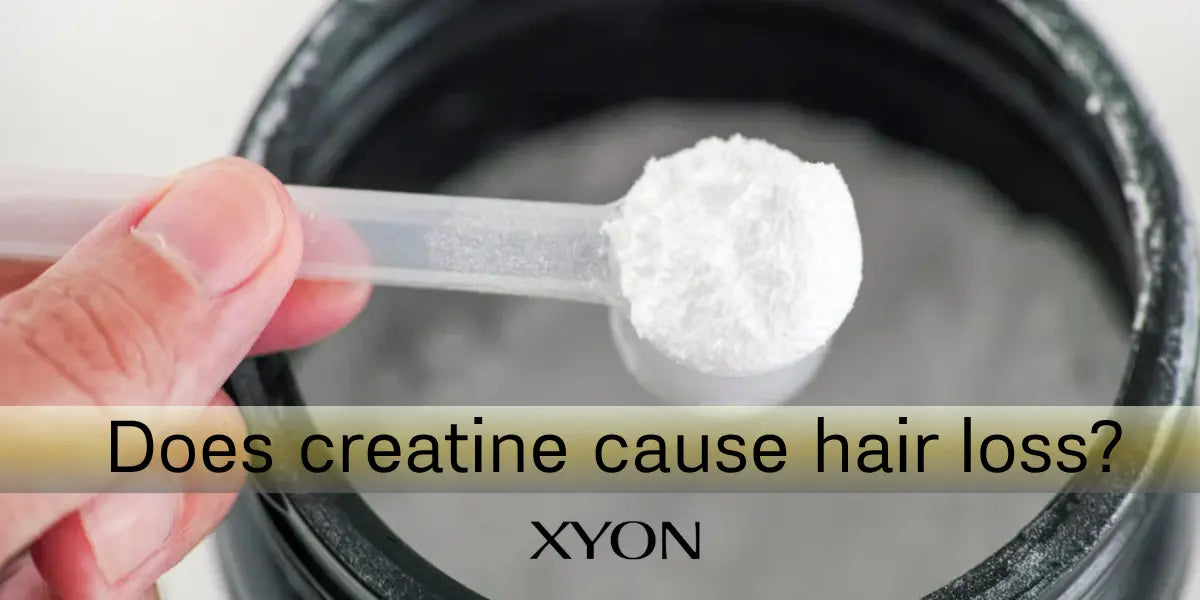Finasteride is a clinically proven treatment for men’s hair loss that’s available in two formats: oral tablets (FDA-approved at a dosage of 1mg/day) and compounded topical formulas. In this article we’ll cover the essential information you need to start understanding the differences between these formats, including answers to two big questions: is one stronger, or more effective than the other, and is there a difference in side effects? As topical finasteride grows in popularity, it’s important to understand the benefits and possible risks and work with a physician to determine whether it could be an option for treating your hair loss.
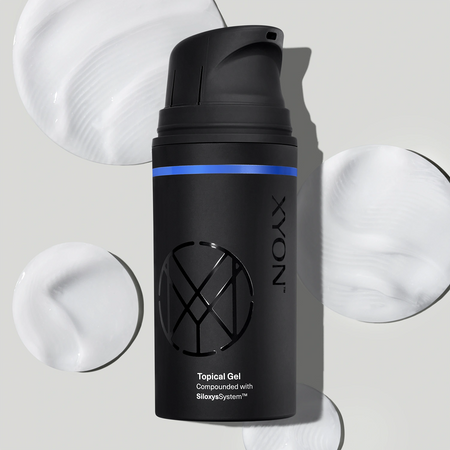
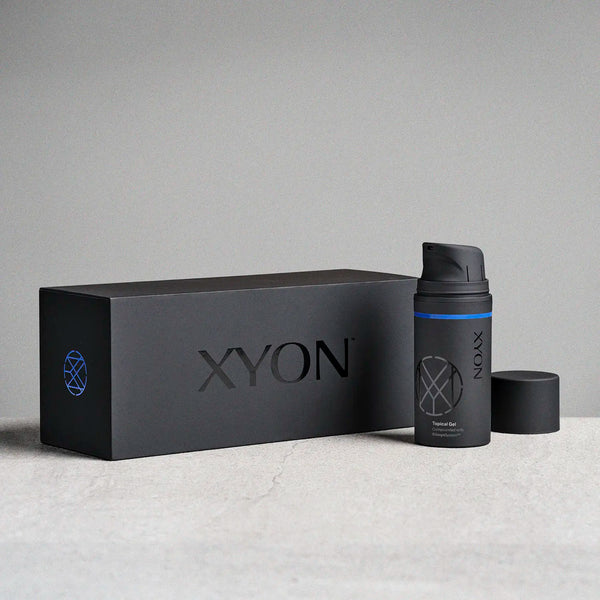
Worried about side effects from finasteride? Meet topical finasteride.
XYON's topical finasteride is designed to maximize effectiveness while lowering the risk of side effects.
What is finasteride?
Finasteride is a type of medication called a 5-alpha reductase inhibitor (5-ARI). It works by stopping some of the testosterone in your body from being converted into a closely related hormone called dihydrotestosterone (DHT). In men who are genetically at risk for pattern hair loss, high levels of DHT can cause hair follicles to shrink and stop producing hair. This leads to the typical thinning and balding that people associate with this hair loss condition. Finasteride can help slow this process down by keeping DHT levels low, and the medication will help maintain these lower levels as long as you keep taking it.
The safety and efficacy of finasteride have been studied in countless studies since the drug was first approved to treat hair loss. It works well because it targets the root cause of hair loss but as with other medications, there are safety risks that you should be aware of. You can visit our article about the side effects of finasteride to learn more.
You can get finasteride prescribed as a 1mg oral tablet or as a compounded topical medication. Compounded treatments are not FDA-approved, but can contain FDA-approved ingredients (finasteride, in this case). They may differ in format and strength from FDA-approved treatments and are customized to meet the needs of patients. Currently, there are no standards for the type of formula (e.g., solution, gel, foam) or concentration of topical finasteride, so it’s important to do research to understand the possible benefits and risks of the topical treatment you’re considering.
For example, at XYON we currently offer three different topical formulations with finasteride: two compounded in our exclusive SiloxysSystem™ Gel base (one with finasteride only and another with both finasteride and minoxidil) and one in an alcohol base (finasteride with minoxidil). SiloxysSystem™ Gel may be an option for patients who are looking for results with a potentially lower risk of side effects, while the alcohol-based solution might appeal to individuals who want something effective, but at a lower starting concentration. Finasteride works in the same way in all these formulations, but different delivery methods can have an effect on the amount of finasteride that’s absorbed into the body, which can affect the risk of side effects.
Is oral finasteride stronger than topical?
Not necessarily. In some cases, topical finasteride may be compounded with a higher concentration of finasteride, making it a “stronger” treatment because it contains more finasteride per dose.
We know that the oral tablet contains exactly 1mg of finasteride. You can use a simple calculation to figure out how many milligrams are inside a bottle of topical finasteride (you’d need to know the concentration and volume of your bottle) but there’s a catch—the actual amount delivered to the hair follicles may not be this exact number. Let’s examine why.
When you take oral finasteride, it needs to pass through the digestive system and is partly processed by the liver before the drug reaches the hair follicles. During this process, some of the finasteride is broken down or removed from the body. A similar, but different process occurs after you apply topical finasteride, except this time, some of the medication is lost in the process of it entering the skin. This is why it’s generally not recommended to directly compare the strength of oral to topical medications, because the way these medications are metabolized (broken down) is very different.
Is topical finasteride better than oral?
Stronger isn’t necessarily better. With any medication, higher doses can also increase the risk of certain side effects if more medication is absorbed into the bloodstream. In the case of our topical finasteride and topical finasteride with minoxidil compounded in SiloxysSystem™ Gel, the gel was specifically designed to keep finasteride in the scalp skin and out of the body. It's one of the reasons why, despite having a higher dose than most other topical finasteride formulations available on the market, patients have reported experiencing fewer side effects. You can learn more about this unique technology by checking out our article on the clinical studies that were done on this gel.
Is the finasteride pill more effective for stopping hair loss than topical?
Not necessarily, but we have more data on the effectiveness of oral finasteride. Fortunately, there’s a growing body of research on the efficacy of topical finasteride as a possible alternative for patients who are concerned about possible side effects.
A recent 2021 study that was conducted on male patients aged 18-40 with mild to moderate pattern hair loss tested a 0.25% topical finasteride spray against oral finasteride and a placebo (Piraccini et al., 2021). After 24 weeks of treatment, the patients who used topical finasteride showed significant improvement in hair count compared to the placebo group (an average change from baseline of 20.2 hairs vs 6.7 hairs). This improvement in hair count was comparable to the group of patients who received oral finasteride (20.2 hairs vs 21.1 hairs).
An earlier 2009 study enrolled 45 male patients with pattern hair loss and compared a 1% topical finasteride gel to oral finasteride (Hajheydari et al., 2009). The study found that after 6 months of treatment, total hair count significantly increased in both treatment groups. The researchers concluded that oral and topical finasteride were similarly effective. To date, there are no studies that compare the long-term effectiveness of oral vs topical finasteride therapy, but some data shows that long-term use of finasteride (in general) can have a positive impact on the prevention of further hair loss (Yanagisawa et al., 2019).
There are several factors that can affect the efficacy of hair loss treatment, including adherence to treatment (how consistent you are with taking or using your medication), the severity of your hair loss, or even genetic differences in how your body metabolizes certain drugs. It’s not uncommon for doctors to recommend adding different, complementary treatments (such as minoxidil) to try to increase the effectiveness of a treatment regimen by targeting other causes of hair loss or suboptimal hair growth.
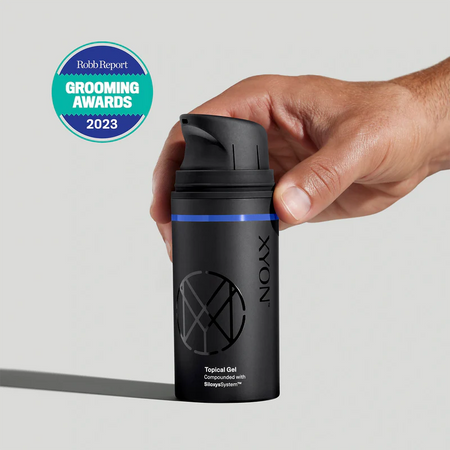
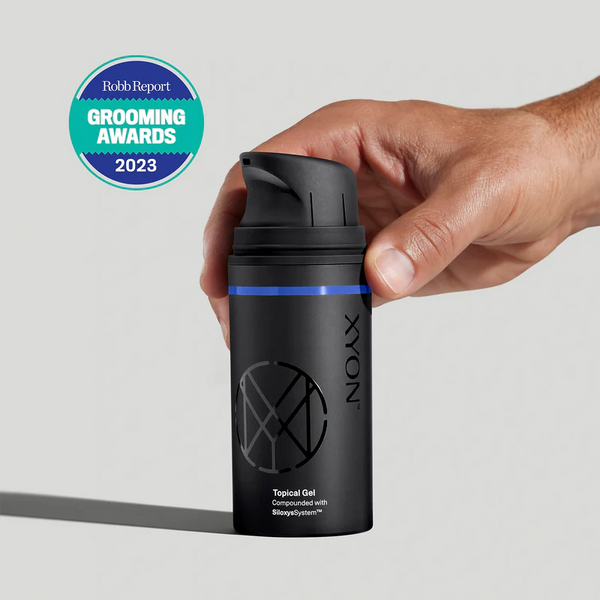
Side effects while taking oral finasteride? Topical finasteride might be an option.
Minimize the chances of side effects without losing any hair loss stopping benefits.
Is topical finasteride safer than the pill?
Potentially, but remember, there’s no standard delivery format or concentration for topical finasteride, so the safety of topical formulations can vary greatly. In general, topical medications are associated with a lower risk of side effects compared to oral medications because there’s a lower risk of absorption into the bloodstream with the former. Finasteride that’s absorbed into the body can affect DHT levels and cause unwanted effects in tissues that are sensitive to hormonal changes.
The most common type of side effects associated with the use of finasteride are sexual side effects and these can include:
- Erectile dysfunction
- Decreased libido (sex drive)
- Ejaculatory disorders
Side effects such as beast pain and/or tenderness or unusual breast discharge have also been reported, in addition to mood or psychiatric changes, including depression and in extreme cases, suicidal ideation. When comparing side effects of topical finasteride to oral finasteride, it’s important to understand that the topical format doesn’t eliminate the possibility of side effects, but it can lower this risk. Accordingly, there is some study data to support that topical finasteride doesn’t increase the risk of systemic side effects, but local skin irritation can occur because treatment is applied directly to the skin (Lee et al., 2018).
This area would benefit from additional research, because findings haven’t necessarily been consistent. One study analyzed and compared DHT levels in patients after 1 week of treatment with a 0.25% topical finasteride solution and 1 week of treatment with oral finasteride and found that DHT was similarly suppressed (Caserini et al., 2014). However, a separate study that also compared a 0.25% topical spray to oral finasteride found that after 24 weeks of treatment, oral finasteride lowered DHT levels by approximately 20% more than the topical spray (Piraccini et al., 2021). It’s worth pointing out that not all patients who undergo changes in DHT will go on to experience side effects, but how significant these hormonal changes are, can be an indication of how well a topical formulation keeps finasteride out of the body.
Can oral and topical finasteride be used together?
There is not a lot of data on whether or not using oral and topical finasteride together improves results or limits side effects. Some people attempt this thinking they are getting the benefits of both and in very specific situations a doctor may try this route for a patient but using both can cause the same side effects users want to avoid. If you decide to try both make sure you speak with a doctor first so they can monitor you in case you do get any side effects.
Does topical finasteride go systemic?
It can. As previously mentioned, there are no topical vehicles that completely prevent the absorption of finasteride and different formulations can vary in how well they limit systemic exposure to finasteride.
Our patented delivery technology SiloxysSystem™ Gel has several unique features that help keep finasteride in the scalp and out of the body. First, it has barrier-forming ingredients that form a physical layer on top of the skin to “hold” finasteride in place, releasing it slowly over time. Second, finasteride is loaded onto small molecules called liposomes that help carry the medication to the layer of skin where hair follicles are located. These features help keep more finasteride in the skin and out of the bloodstream.
For those concerned about systemic exposure, we also offer a compounded low dose topical finasteride and minoxidil solution (without the gel) featuring a lower concentration of finasteride.
Can I switch from oral to topical finasteride?
In many cases, yes. If you’ve already been taking oral finasteride and want to switch to a topical formulation, the first step is to connect with your prescribing doctor. They’ll consider your medical history and how you’ve responded to oral finasteride when determining whether you can safely make the switch. At XYON, you can easily request a prescription change through your user portal.
Patients can sometimes experience increased shedding when changing hair loss treatments (even if it’s a change in strength or concentration). This is because hair follicles are transitioning to a new hair growth cycle. Generally, this shedding is temporary and will resolve on its own over the course of a few weeks. If the shedding doesn’t go away or if it becomes worse, please reach out to your prescribing doctor.
Once you’ve been issued a prescription and received your treatment, simply apply topical finasteride per the instructions indicated on your prescription.
Takeaway: oral vs topical finasteride
With topical finasteride becoming an increasingly popular option for treating hair loss, we want to make sure that you have the information you need to make an informed decision. Oral finasteride and topical finasteride treat thinning hair in the same way, by blocking the production of DHT, preventing the hormone from attacking hair follicles and causing the progression of hair loss. Research on the efficacy of topical finasteride is growing, and available data suggests that it may be as effective as the oral tablet at promoting hair regrowth. However, because topical finasteride isn’t FDA-approved, there are no strict guidelines for the concentration of finasteride or the type of vehicle (gel, solution, foam, etc.). This means that there may be significant variation in efficacy, and potentially safety, between different topical finasteride formulas.
The biggest difference between oral vs topical finasteride is in the potential amount of systemic exposure to finasteride. Topical medications are associated with lower drug exposure because they’re applied directly to the skin. As a result, the risk of developing systemic side effects may be lower and this does seem to be supported by some clinical studies that report fewer cases of sexual side effects in patients treated with topical finasteride. Topical finasteride could be a solution for patients who want to take advantage of the effectiveness of finasteride but are worried about possible side effects.
Ready to take the next step? Start a consultation today with a hair loss specialist to find out if topical finasteride could help you get closer to your hair goals.
References:
Caserini, M., Radicioni, M., Leuratti, C., Annoni, O., & Palmieri, R. (2014). A novel finasteride 0.25% topical solution for androgenetic alopecia: pharmacokinetics and effects on plasma androgen levels in healthy male volunteers. International Journal of Clinical Pharmacology and Therapeutics, 52(10), 842–849. https://doi.org/10.5414/CP202119
Hajheydari, Z., Akbari, J., Saeedi, M., & Shokoohi, L. (2009). Comparing the therapeutic effects of finasteride gel and tablet in treatment of the androgenetic alopecia. Indian Journal of Dermatology, Venereology and Leprology, 75(1), 47–51. https://doi.org/10.4103/0378-6323.45220
Lee, S. W., Juhasz, M., Mobasher, P., Ekelem, C., & Mesinkovska, N. A. (2018). A Systematic Review of Topical Finasteride in the Treatment of Androgenetic Alopecia in Men and Women. Journal of Drugs in Dermatology: JDD, 17(4), 457–463. https://www.oatext.com/Long-term-(10-year)-efficacy-of-finasteride-in-523-Japanese-men-with-androgenetic-alopecia.php#Article
Piraccini, B. M., Blume-Peytavi, U., Scarci, F., Jansat, J. M., Falqués, M., Otero, R., Tamarit, M. L., Galván, J., Tebbs, V., Massana, E., & Topical Finasteride Study Group (2022). Efficacy and safety of topical finasteride spray solution for male androgenetic alopecia: a phase III, randomized, controlled clinical trial. Journal of the European Academy of Dermatology and Venereology: JEADV, 36(2), 286–294. https://doi.org/10.1111/jdv.17738
Yanagisawa, M., Fujimaki, H., Takeda, A., Nemoto, M., Sugimoto, T., & Sato, A. (2019). Long-term (10-year) efficacy of finasteride in 523 Japanese men with Androgenetic Alopecia. Clinical Research and Trials, 5(5). https://doi.org/10.15761/crt.1000273



